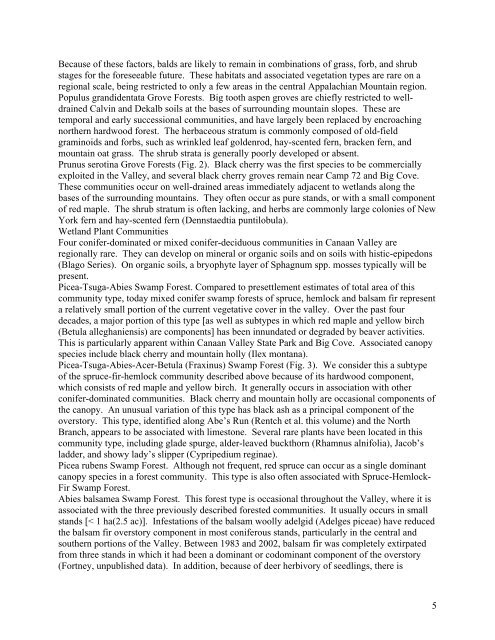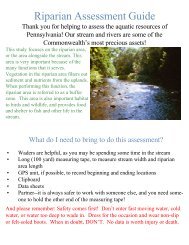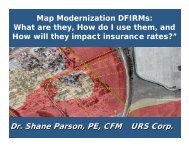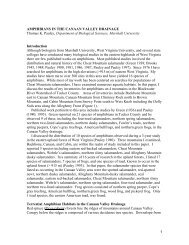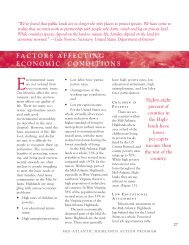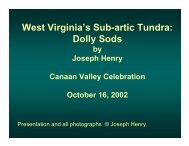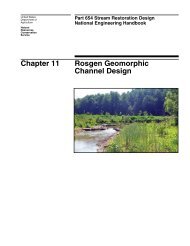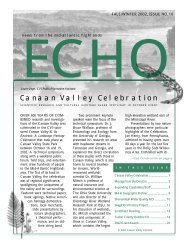rare plant communities in canaan valley, west virginia
rare plant communities in canaan valley, west virginia
rare plant communities in canaan valley, west virginia
Create successful ePaper yourself
Turn your PDF publications into a flip-book with our unique Google optimized e-Paper software.
Because of these factors, balds are likely to rema<strong>in</strong> <strong>in</strong> comb<strong>in</strong>ations of grass, forb, and shrubstages for the foreseeable future. These habitats and associated vegetation types are <strong>rare</strong> on aregional scale, be<strong>in</strong>g restricted to only a few areas <strong>in</strong> the central Appalachian Mounta<strong>in</strong> region.Populus grandidentata Grove Forests. Big tooth aspen groves are chiefly restricted to welldra<strong>in</strong>edCalv<strong>in</strong> and Dekalb soils at the bases of surround<strong>in</strong>g mounta<strong>in</strong> slopes. These aretemporal and early successional <strong>communities</strong>, and have largely been replaced by encroach<strong>in</strong>gnorthern hardwood forest. The herbaceous stratum is commonly composed of old-fieldgram<strong>in</strong>oids and forbs, such as wr<strong>in</strong>kled leaf goldenrod, hay-scented fern, bracken fern, andmounta<strong>in</strong> oat grass. The shrub strata is generally poorly developed or absent.Prunus serot<strong>in</strong>a Grove Forests (Fig. 2). Black cherry was the first species to be commerciallyexploited <strong>in</strong> the Valley, and several black cherry groves rema<strong>in</strong> near Camp 72 and Big Cove.These <strong>communities</strong> occur on well-dra<strong>in</strong>ed areas immediately adjacent to wetlands along thebases of the surround<strong>in</strong>g mounta<strong>in</strong>s. They often occur as pure stands, or with a small componentof red maple. The shrub stratum is often lack<strong>in</strong>g, and herbs are commonly large colonies of NewYork fern and hay-scented fern (Dennstaedtia puntilobula).Wetland Plant CommunitiesFour conifer-dom<strong>in</strong>ated or mixed conifer-deciduous <strong>communities</strong> <strong>in</strong> Canaan Valley areregionally <strong>rare</strong>. They can develop on m<strong>in</strong>eral or organic soils and on soils with histic-epipedons(Blago Series). On organic soils, a bryophyte layer of Sphagnum spp. mosses typically will bepresent.Picea-Tsuga-Abies Swamp Forest. Compared to presettlement estimates of total area of thiscommunity type, today mixed conifer swamp forests of spruce, hemlock and balsam fir representa relatively small portion of the current vegetative cover <strong>in</strong> the <strong>valley</strong>. Over the past fourdecades, a major portion of this type [as well as subtypes <strong>in</strong> which red maple and yellow birch(Betula alleghaniensis) are components] has been <strong>in</strong>nundated or degraded by beaver activities.This is particularly apparent with<strong>in</strong> Canaan Valley State Park and Big Cove. Associated canopyspecies <strong>in</strong>clude black cherry and mounta<strong>in</strong> holly (Ilex montana).Picea-Tsuga-Abies-Acer-Betula (Frax<strong>in</strong>us) Swamp Forest (Fig. 3). We consider this a subtypeof the spruce-fir-hemlock community described above because of its hardwood component,which consists of red maple and yellow birch. It generally occurs <strong>in</strong> association with otherconifer-dom<strong>in</strong>ated <strong>communities</strong>. Black cherry and mounta<strong>in</strong> holly are occasional components ofthe canopy. An unusual variation of this type has black ash as a pr<strong>in</strong>cipal component of theoverstory. This type, identified along Abe’s Run (Rentch et al. this volume) and the NorthBranch, appears to be associated with limestone. Several <strong>rare</strong> <strong>plant</strong>s have been located <strong>in</strong> thiscommunity type, <strong>in</strong>clud<strong>in</strong>g glade spurge, alder-leaved buckthorn (Rhamnus alnifolia), Jacob’sladder, and showy lady’s slipper (Cypripedium reg<strong>in</strong>ae).Picea rubens Swamp Forest. Although not frequent, red spruce can occur as a s<strong>in</strong>gle dom<strong>in</strong>antcanopy species <strong>in</strong> a forest community. This type is also often associated with Spruce-Hemlock-Fir Swamp Forest.Abies balsamea Swamp Forest. This forest type is occasional throughout the Valley, where it isassociated with the three previously described forested <strong>communities</strong>. It usually occurs <strong>in</strong> smallstands [< 1 ha(2.5 ac)]. Infestations of the balsam woolly adelgid (Adelges piceae) have reducedthe balsam fir overstory component <strong>in</strong> most coniferous stands, particularly <strong>in</strong> the central andsouthern portions of the Valley. Between 1983 and 2002, balsam fir was completely extirpatedfrom three stands <strong>in</strong> which it had been a dom<strong>in</strong>ant or codom<strong>in</strong>ant component of the overstory(Fortney, unpublished data). In addition, because of deer herbivory of seedl<strong>in</strong>gs, there is5


